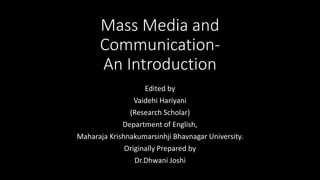Wondered how media information comes to us? How does mass media communication work and what impact does it have? This blog post aims to explore mass media communication basics and how it affects us. Covering different types and effects, it offers a comprehensive introduction to the subject. By post’s end, you will have better understanding of media workings and its impact.
To Gain a Deeper Understanding: benedict cusack
What is Mass Media Communication?
Mass media communication plays a crucial role in modern society by sharing information, ideas, and opinions through various mediums such as television, radio, newspapers, magazines, and the internet. Its impact on public discourse and our lives is profound, and comprehension of its intricacies can lead to a better understanding of its role in society.
At its core, mass media communication aims to disseminate information on a large scale, allowing people worldwide to access news and entertainment. As an influential tool for social change, it empowers citizens by providing them with the knowledge required to make informed decisions on current issues. Technology has revolutionized mass communications, providing access to information more quickly and accurately than ever before. It also facilitates better analysis of messages from various media sources, helping us understand their implications better.
Global media cultures are also a topic of discussion, as popular culture trends and shared experiences spread through digital platforms like YouTube and Netflix. It is vital for students studying this field to understand the aspects involved in creating and traveling masses of media across societies and cultures.
Ethical concerns such as censorship, privacy, and trustworthy advertising campaigns in online media also need to be considered while studying this field. The use of technology like video conferencing tools or virtual reality simulations can improve students’ engagement and further their understanding of this exciting field, leading to new skill sets.
In conclusion, studying mass media communication can provide insights into power dynamics within the industry and assist in thinking critically when it comes to creating a better collective experience.
How Mass Media Communicates Ideologies and Shapes Public Opinion
Mass media communication is a powerful tool that shapes public opinion, creates and transmits ideologies, and influences behavior. To gain insight into its power and potential, it’s essential to understand the different roles and functions of mass media. This article explores how mass media communicates ideologies and shapes public opinion through various topics.
First, we examine the political and economic context in which the public views and interprets media messages. We look at how different ideologies are communicated through mass media and their impact on society. We also discuss technology’s role in shaping and being shaped by mass media.
Next, we discuss issues related to control over published or broadcasted content, including censorship. We also explore potential impacts of sociotechnical changes on content production. We review theories, models, and concepts related to mass communication, such as agenda setting theory and uses-and-gratification theory. Additionally, we delve into current trends in the field that could have implications for the future.
Finally, we explore how advertising and news outlets use news stories and entertainment programming to shape individual beliefs, opinions, and behaviors. We also examine ethical issues associated with their assignment, publication, distribution, and consumption. We end our journey by investigating the relationship between culture and mass communication and offer some conclusions about the power, influence, and reach of mass media. As seen, there is much to learn about studying the area of Mass Media Communication – Understanding Introduction is the perfect place to start!
Read To Learn More Interested Info: The Evolution of Mass Media Communication-From Print to Digital
How Does Mass Media Impact Our Daily Lives?
In the digital age, mass media communication profoundly impacts our daily lives. Mass media platforms are used to influence society and drive consumer demand, shaping our opinions and behavior. Mass communication reaches a large audience with a single message or image through different forms of media such as TV shows, radio broadcasts, websites, magazines, newspapers, and even billboards. By understanding how these forms of media shape our values and beliefs, we gain insight into public opinion. However, mass media can also be employed in less ethical ways, such as manipulating information or using fearmongering tactics. Therefore, examining these ethical implications is essential to consume media responsibly while enjoying its benefits.
Moreover, mass media communication impacts social movements by creating visibility for certain causes or allowing people from different backgrounds to come together virtually. Messages spreading faster through different mediums like email newsletters or podcasts make it easier for traditionally excluded individuals to have their voices heard.
Finally, to communicate effectively through various forms of media, it is crucial to consider your target audience and take into account changes in technology. This helps in making informed decisions when communicating your message across different platforms while also considering future trends related to media technology for staying ahead of the competition when planning your next campaign. All in all, understanding how mass media communication impacts our daily lives is more critical than ever before.
Analyzing How the Media Shapes Our Perceptions
“Understanding mass media communication is crucial in this day and age as it influences almost every aspect of our lives. To gain a deeper understanding of it, we must analyze how the different types of mediums convey messages and explore the power certain mediums have in shaping our thoughts and opinions.
All forms of communication that involve large numbers of people or groups are called Mass Media Communication. It encompasses various mediums such as television, radio, print publications (newspapers & magazines), as well as online platforms such as social networking sites, blogs & websites. Knowing which medium works best for each message can help ensure your target audiences receive your message clearly without any misinterpretation or ambiguity.
It’s important to note the power of certain mediums when it comes to influencing public opinion. By considering mass media theories such as agenda-setting theory and cultivation theory, we can better understand how news stories or ad campaigns influence public opinion on important matters like politics or consumer products.
New technologies are also changing the way information is shared through digital culture, from streaming services like Netflix & Hulu, social networks connecting people around the world, to virtual reality and big data analytics helping businesses understand customer behavior better.
In discussing Mass Media Communication, it’s important to consider its history, purpose/role within society/culture/individual life, major terms/concepts, impact on society/culture/individual life, and its current status worldwide. With this knowledge, you should have an increased understanding about Mass Media Communication and the vital role it plays in today’s society.”
In Conclusion
“Mass media communication is a powerful tool that shapes public opinion, creates and transmits ideologies, and influences behavior. It has a profound impact on our lives. Understanding how it works can help us make better informed decisions when engaging with media. Technology has revolutionized mass communication, providing access to information more quickly and accurately than ever before. With these insights in mind, it is essential to be aware of the ethical implications of engaging with media responsibly while enjoying its benefits. Researching current trends in this field and critically analyzing the role of different mediums in shaping public opinion can help us further explore the impact of mass media communication on our daily lives.”




